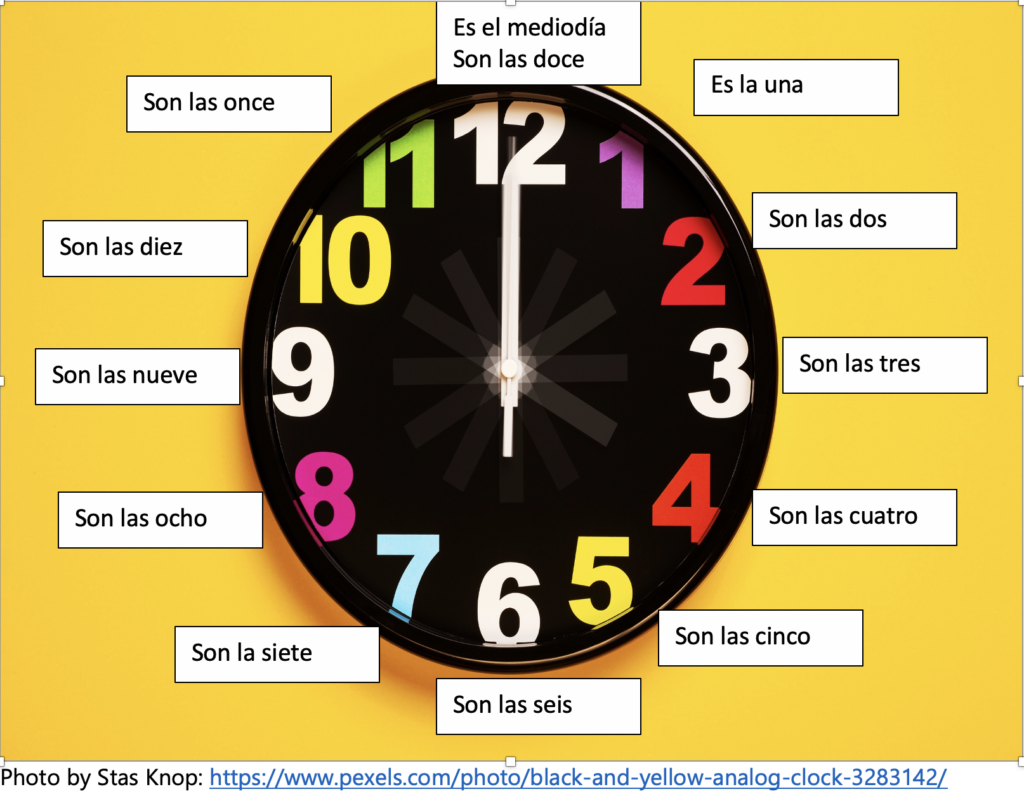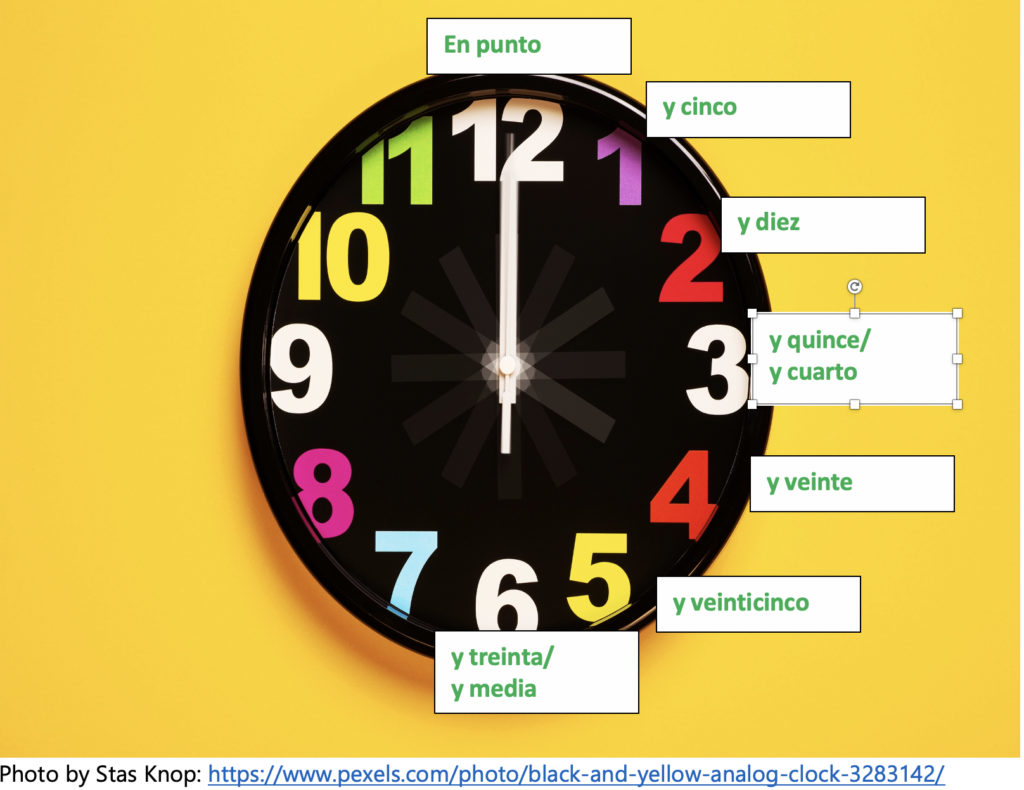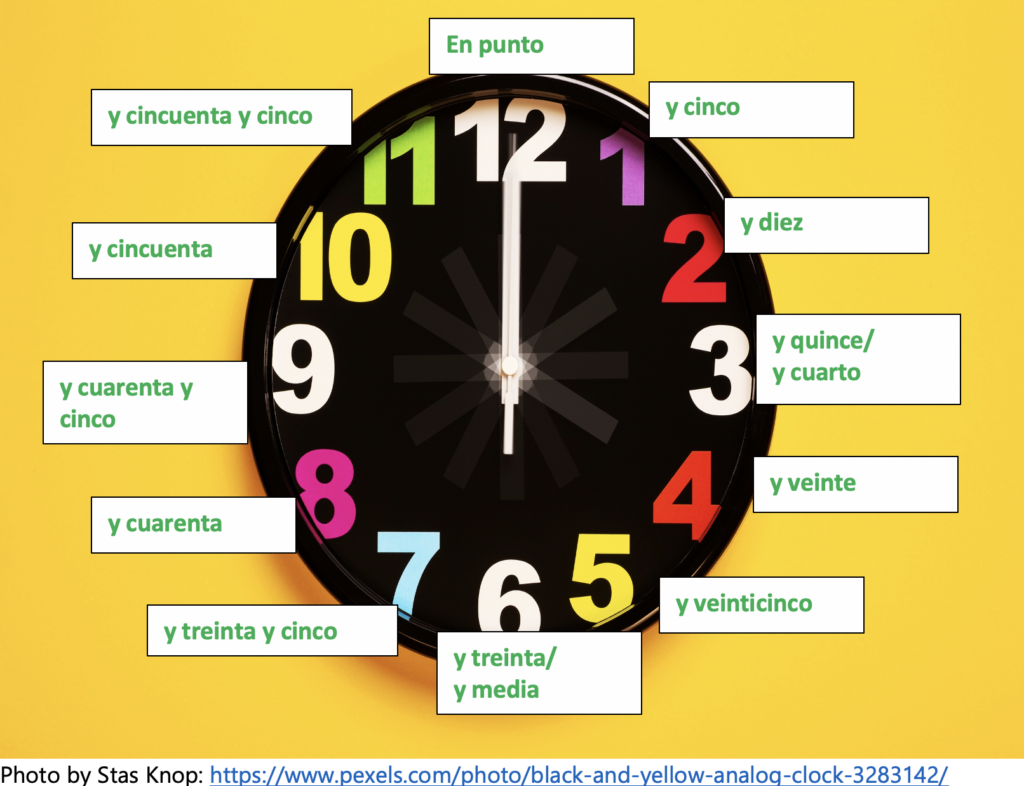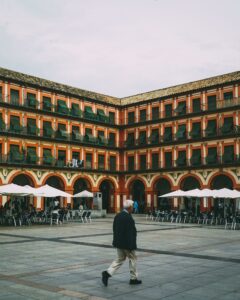2 Mis amistades
Objectives
Communicative goals
- Describe daily activities.
- Make plans with friends.
- Express likes and dislikes.
Cultural goals
- Compare and contrast activities that young people in different parts of the Hispanic world enjoy and consider entertainment.
- Compare and contrast climates and the months in which different regions of the world experience their seasons.
I. Tira cómica
You will follow Ana and Carlos as they discuss their favorite activities and spend time together.







Actividad 2.1. Comprehension check
Answer the following questions based on the tira cómica.
II. ¿Te fijaste que…? Los pasatiempos en el mundo hispano
Las actividades de los jóvenes
Conexión cultural: Las actividades de los jóvenes
¿Tienes planes? Across the globe, young people everywhere ask each other a similar question and gather with their friends for shared activities. While the specific activities and locations might vary regionally (as you will see below), it is important to remember that the desire for social connections and an active social life are universal aspects of the human experience.
It shouldn’t be surprising, then, as you have previously read, that there are many cognates between Spanish and English when it comes to activities we engage in with friends. Even the word actividad is a cognate, as are música and televisión as well as the names of several sports. Since the words are new to you, you may not identify the cognates when you hear them at first. Take some time slowly reading, writing, and pronouncing the vocabulary words, and you will certainly see the connection between the words in both languages. Parque, restaurante, café, cartas…once you start to identify the cognates, you will see them everywhere!
Actividad 2.2. Las actividades de los jóvenes
Use the information Carlos and Ana share in the tira cómica to answer whether the given activity (a) le gusta a Carlos (Carlos likes it), (b) le gusta a Ana (Ana likes it), or (c) les gusta a Carlos y a Ana (they both like it).
Modelo:
Mirar las películas
c. Les gusta a Carlos y a Ana
Actividad 2.3. El fútbol
Use the tira cómica to answer the following questions. Indicate whether the statements are cierto o falso.
Conexión cultural: El fútbol
When you hear the word fútbol, what image comes to mind? Carlos says, “En mi país, el fútbol es una pasión.” El fútbol es el deporte más popular en el mundo. También es el deporte más popular en los países hispanos.
In most English-speaking countries around the world (e.g., the UK, South Africa, New Zealand, Jamaica, India, and to some extent, Australia) except North America (that is, in Canada and the United States), the term football means the same thing as it does with Spanish fútbol: American soccer.
Especially in Spanish-speaking countries—but also in many countries around the world—fútbol, or soccer, has a tremendously passionate following. In Spanish-speaking countries, soccer is more than just a sport; it is a cultural touchstone. It is a way to spend time and commune with family, friends, and neighbors. Playing soccer, talking about it, cheering on the local team, or disparaging the rival team occur frequently and create a sense of community. While, of course, every person and every family is different, this kind of passion for fútbol is quite widespread in the Spanish-speaking world. This doesn’t mean that soccer is the only professional sport with a following, but soccer’s popularity does eclipse other sports by a wide margin in these countries.
The closest equivalent to the popularity of soccer in the United States is American football or basketball. Take a moment to think about a friend or relative who hosts a party every Sunday when their (American) football team is playing or spends several weeks in marzo and abril glued to the televisión and comparing results of the NCAA men’s basketball tournament with their personal brackets. Perhaps you are one of these people who, because of personal experience, family ties, or hometown loyalty, live the passion for a particular sport with gusto and enthusiasm (when your team does well) or dismay and despair (when it doesn’t). For a variety of reasons, fútbol is gaining popularity in the United States as well. Even if American football may dominate soccer in terms of professional following, soccer is an extremely popular and widespread youth sport.
Actividad 2.4. Investigación cultural: Los equipos y las estrellas de fútbol
Use your resources to learn about some popular and important equipos y jugadores de fútbol in a Spanish-speaking country. Find a few images to share with your classmates and prepare to present on the following in Spanish:
- The name of at least one popular or important soccer team.
- Where that team plays (stadium, city, and country).
- The name of a famous soccer star from the country.
- One interesting fact you learned about soccer in the country or the team or player you chose. (This fact can be in English.)
Helpful vocabulary:
| El equipo | The team |
| El/la jugador/a | The player |
| Famoso/a | Famous |
| El estadio | The stadium |
| La estrella | The star (both the celestial body and famous/talented person) |
La medida de distancia, peso y temperatura
Actividad 2.5. La medida de distancia, peso y temperatura
Use the tira cómica to answer the following questions.
Conexión cultural: La medida de distancia, peso y temperatura
If you have ever tried to use a recipe from another country or figure out what temperature it was in a different place in the world, you probably have already realized that the units of measurement used in the United States are not the same as in other countries. In fact, the United States is only one of three countries in the entire world that do not use the metric system, though there are certainly some instances (for example, short running distances and scientific study generally) where you will also find metric measurements in the US.
Spanish-speaking countries—as well as most of the world—use the metric system to measure units. Where Americans say inches and feet, others say centimeters and meters. When Americans state our weight and buy our produce in pounds, others use kilograms (or generally, “kilos”). Where you are used to hearing the weather reported in degrees Fahrenheit, others say Celsius. And when it comes to distances and speed, where our speedometer says miles per hour, others say…you guessed it! Kilometers. One mile is approximately 1.6 kilometers. If Carlos runs around 42 kilometers in a marathon, how many miles does he usually run?
Actividad 2.6. Investigación cultural: Temperatura
- Find a temperature converter and look up the equivalent of the following temperatures in degrees Celsius:
- 70 degrees F
- 32 degrees F
- 100 degrees F
- 2 degrees F.
- What might be the advantages and disadvantages if the United States were to convert to the metric system? Do you think this is a viable or worthwhile option to consider?
¿Por qué no vamos a pasear?
Actividad 2.7. ¿Por qué no vamos a pasear?
Use the tira cómica to answer the following questions.
Conexión cultural: ¿Por qué no vamos a pasear?
In Spanish-speaking countries generally, but particularly in more urban environments, it is common for friends to meet up at a central landmark in town, such as a plaza. Plazas are similar to town squares and tend to be well-maintained open-air spaces near shops, restaurants, and important public buildings. There is often a fountain or a key monument or architectural focal point in the center.
Whether it’s a plaza, a park, or even a centro comercial, one of the key things these places have in common is that they represent important meeting places for friends and family. Year round, but of course especially in good weather, there is a strong tradition in Spanish-speaking countries to meet up in a public place and go for a stroll. Often the friends or the group will end up at a café, bar, or restaurant for some refreshments and then will continue on their stroll to potentially end up in another place.
While it depends on the resources and desires of individual families, it is even quite common for barbecues and other larger gatherings to take place in public spaces, such as a park. Whether it’s with one friend or many, socializing very often takes place in public.
Actividad 2.8. Conexión personal: ¿En privado o en público?
Paso 1 – Read the following activities and decide whether they are generally done en casa (at home), en un espacio público, or los dos (both).
| En casa | En un espacio público | Los dos | |
| Mirar una película | |||
| Practicar un deporte | |||
| Pasear | |||
| Tomar un café | |||
| Tocar música | |||
| Conversar con amigos | |||
| Leer un libro |
Paso 2 – Now, share your answers with a partner. ¿Están de acuerdo? (Do you agree?)
What do you think might be your personal cultural perspective about socializing and the role of one’s home and personal space in this process? How might this be different from Carlos’s perspective?
El transporte y la urbanización
Actividad 2.9. El transporte y la urbanización
Use the tira cómica to answer the following questions.
Conexión cultural: El transporte y la urbanización
It is no secret that in many places in the United States, the automobile is the most popular form of transportation. There are quite a few reasons for this—an abundance of space and the historical importance of Ford and other car factories to the region being two major reasons—and the end result is that many cities are more “drivable” than “walkable,” especially as one gets further out from urban centers.
As always, there is a great deal of variability among and within countries, but in many places in the Spanish-speaking world, the availability and use of public transportation is much more widespread. Many individuals are able to access places like markets, restaurants, and public services on foot or through a combination of public transport and walking. Furthermore, whereas many midwestern Americans might view using public transportation as an inconvenience, a novelty, or a last resort, for many individuals in the Hispanic world, it is convenient, affordable, and the best way to get from point A to point B. This is because many large cities in the Hispanic world have traffic and parking issues that are avoided when public transportation is taken. In addition, many countries like Mexico and Colombia have placed restrictions on the use of personal vehicles in order to alleviate pollution in certain cities. Programs like “Un día sin carro y sin moto” in Colombia prohibit the use of cars and motorcycles one day a month. In Mexico City, the program “Hoy no circula” limits the use of personal vehicles during certain days of the month and hours of the day.[1] Therefore, most individuals are accustomed to using public transportation at one point or another.
These systems are incredibly varied and diverse and, as expected, are called by different names in different places. Some of the oldest and most innovative systems of public transportation are in Spain and Latin America. In Buenos Aires, Argentina, the first line of the subterráneo (“metro”; literally, “underground”), referred to as the subte, Línea A was established in 1913. It has undergone renovations since then, of course, but it is still in use.[2] El Metrocable in Medellín, Colombia, was the world’s first cable car public transport system. Established in 2004, it offers a clean, sustainable, and economical public transport option in a mountainous area that would be difficult to navigate using other types of transportation.[3] Spain’s high-speed rail system, the AVE, is a convenient choice for intercountry travel. The AVE boasts of the longest high-speed line in Europe, with 3,100 kilometers of rail, and can reach speeds of up to 310 kilometers per hour.[4]
Actividad 2.10. The Buses of Bogotá
Watch the video about the buses of Bogotá.
As you watch, indicate whether each statement is cierto or falso.
El transporte y la urbanización
III. Ampliación: La comunicación virtual
Actividad de reflexión cultural 2.11. Los pasatiempos digitales
Actividad 2.12. Los pasatiempos digitales
People in all parts of the world use digital means to engage with one another and participate in many of their daily habits and activities. Whereas Snapchat, text messages, iMessage, and FaceTime are likely the predominant applications Americans use to connect directly with one another outside of social media platforms, WhatsApp is the most commonly used messaging and chat application used in the Spanish-speaking world. Read the article “How WhatsApp Took Over Latin America” and answer the questions below: https://mobilegrowthassociation.com/how-whatsapp-took-over-latin-america/.
IV. Vocabulario
| Días, meses y estaciones (Español) | Days, months, and seasons (English) |
| El lunes | Monday |
| El martes | Tuesday |
| El miércoles | Wednesday |
| El jueves | Thursday |
| El viernes | Friday |
| El sábado | Saturday |
| El domingo | Sunday |
| Enero | January |
| Febrero | February |
| Marzo | March |
| Abril | April |
| Mayo | May |
| Junio | June |
| Julio | July |
| Agosto | August |
| Septiembre | September |
| Octubre | October |
| Noviembre | November |
| Diciembre | December |
| La primavera | Spring |
| El verano | Summer |
| El otoño | Fall |
| El invierno | Winter |
| Expresiones para hacer planes (Español) | Expressions to make plans (English) |
| ¿Tienes…? | Do you have…? |
| Tengo… | I have… |
| Tengo que… | I have to… |
| Estoy libre. | I am free. |
| ¿Quieres…? | Do you want (to)…? |
| Quiero… | I want (to)… |
| Voy a (+ infinitive)… | I am going to… |
| Vamos a (+ infinitive)… | Let’s… / We are going |
| Podemos… | We can… |
| ¿Puedes? | Can you? |
| (No) Puedo…( | I can / I can’t… |
| ¡Exacto! | Exactly! |
| ¡Claro! | Of course! / Sure! |
| ¡Me parece bien! | It sounds good! |
| ¡Qué bien! | Great! |
| De acuerdo. | I agree / OK. |
| Pero… | But… |
| Me gusta… | I like… |
| No me gusta… | I don’t like… |
| Es mejor (+ infintive)… | It’s better (to)… |
| ¡Pásalo bien! | Have a good time! |
| Verbos regulares (Español) | Regular verbs (English) |
| Pasear | To go for a walk |
| Tocar | To play (an instrument) |
| Desear | To wish/desire |
| Necesitar | To need |
| Jugar | To play |
| Tomar | To take/drink |
| Caminar | To walk |
| Cocinar | To cook |
| Descansar | To rest |
| Estudiar | To study |
| Escuchar | To listen |
| Mirar | To watch |
| Celebrar | To celebrate |
| Trabajar | To work |
| Montar | To ride |
| Cambiar | To change |
| Hablar | To talk/speak |
| Participar | To participate |
| Entrenar | To train |
| Practicar | To practice |
| Comer | To eat |
| Correr | To run |
| Beber | To drink |
| Leer | To read |
| Ver | To see |
| Hacer | To make/do |
| Venir | To come |
| Escribir | To write |
| Vivir | To live |
| Asistir | To attend |
| Sustantivos clave (Español) | Key nouns (English) |
| La estación | Season |
| La temperatura | Temperature |
| El clima | Climate/weather |
| El tiempo | Weather/time |
| El sol | Sun |
| La lluvia | Rain |
| La nieve | Snow |
| El lugar | Place |
| La casa | Home/house |
| El interés | Interest |
| El plan | Plan |
| El director | Director |
| La película | Movie |
| La música | Music |
| El grupo | Group |
| La biblioteca | Library |
| La tarea | Homework |
| El examen | Test |
| El parque | Park |
| El museo | Museum |
| El cine | Movie theater |
| El bar | Bar |
| La tienda | Shop/store |
| El café | Café/coffee |
| El restaurante | Restaurant |
| La ciudad | City |
| El tipo (de música) | Type (of music) |
| La organización | Organization |
| El club | Club |
| El trabajo | Job/work |
| El fútbol | Soccer |
| El fútbol americano | Football |
| El baloncesto | Basketball |
| La natación | Swimming |
| El tenis | Tennis |
| La música | Music |
| Las cartas | Cards |
| El jugador | Player |
| El equipo | Team |
| El entrenador | The coach |
| El tenis | Tennis |
| La foto(grafía) | Photo(graph) |
| La televisión/tele | Television/TV |
| La bicicleta | Bicycle |
| La reunión | Meeting |
| El ejercicio | Exercise |
| Expresiones del tiempo y la hora (Español) | Weather and time expressions (English) |
| Hace calor. | It’s hot. |
| Hace frío. | It’s cold. |
| Hace fresco. | It’s cool. |
| Hace buen tiempo. | It’s nice out. |
| Hace mal tiempo. | It’s nasty out. |
| Llueve. | It’s raining. |
| Nieva. | It’s snowing. |
| La estación de lluvia | Rainy season |
| La estación seca | Dry season |
| ¿Qué hora es? | What time is it? |
| Son las… | It’s… (for all times between 2:00 and 12:59) |
| Es la… | It’s… (for times between 1:00 and 1:59) |
| ¿A qué hora es…? | At what time is…? |
| Es a las… | It’s at… |
| Por la mañana / de la mañana | In the morning |
| Por la tarde/de la tarde | In the afternoon/evening |
| Por la noche/de la noche | At night |
| Antes de… | Before… |
| Después de… | After… |
| Durante de… | During… |
| Palabras interrogativas (Español) | Question words (English) |
| ¿Por qué? | Why? |
| ¿Cuándo? | When? |
| ¿Dónde? | Where? |
| ¿Qué? | What? |
| ¿Cuál? | Which? |
| ¿Quién? | Who? (singular) |
| ¿Quiénes? | Who? (plural) |
| ¿Cómo? | How? |
| Verbos irregulares (Español) | Irregular verbs (English) |
| Estar | To be (feelings and locations) |
| Estoy | I am |
| Estás | You are (informal) |
| Está | She/he/it is |
| Estamos | We are |
| Estáis | You all are |
| Están | They/you (formal) are |
| Ir (a) | To go (to) |
| Voy | I go |
| Vas | You (informal) go |
| Va | She/he/it/you (formal) goes |
| Vamos (a) | We go (to) |
| Vais | You all (informal) go |
| Van | They/you (formal) go |
| Ir + a + infinitive | To be going to do something |
| Tener | To have |
| Tengo | I have |
| Tienes | You have |
| Tiene | She/he/it has |
| Tenemos | We have |
| Tenéis | You all have |
| Tienen | They/you have |
| Tener que + inf. | To have to… |
| Tengo que… | I have to… |
| Tienes que… | You have to… |
| Tiene que… | She/he/it has to… |
| Tenemos que… | We have to… |
| Tenéis que… | You all have to… |
| Tienen que… | They/you have to… |
Actividad 2.13. Las actividades
Use the vocabulary list to select the word that best completes each sentence.
Modelo:
Los gimnasios son lugares para _______________.
a. Comer tacos b. Ver películas c. Hacer ejercicio
Actividad 2.14. ¿Dónde lo haces?
Indicate the place where you do each of the following activities.
Modelo:
Sacar libros: En la la biblioteca
- Correr:
- Comer con amigos:
- Escuchar música:
- Comprar regalos (gifts):
- Beber una margarita:
- Ver una película:
- Pasar tiempo con amigos:
Actividad 2.15. ¿Qué hago y dónde lo hago?
Look at the following images and write down at least one activity that you can do there. Use number 1 as a model.
Modelo:

1. El café
__Estudiar __________Beber café _____

|

|

|

|

|

|

|
 9. La biblioteca |
Actividad interpersonal 2.16. Entrevista
With a partner, take turns asking and responding to the following questions. Take notes on what your partner says and be prepared to share with the class.
Modelo:
Estudiante 1:
¿Cuál es tu lugar preferido?
Estudiante 2:
Me gusta el parque.
- ¿Cuál es tu lugar preferido?
- ¿Cuál es tu actividad preferida?
- ¿Qué actividades haces (do you do) con tus amigos?
- ¿Qué actividades haces solo/a (alone)?
- ¿Qué actividades haces en la universidad?
Actividad de investigación cultural 2.17. Las plazas en el mundo hispano
Now that you have learned about the importance of plazas, find information online about some of the most famous plazas in the Spanish-speaking world and prepare a brief presentation for your classmates. You may choose one of the plazas in the list below or find your own.
- El Zócalo en México
- Plaza España en Sevilla, España
- Plaza Mayor en Salamanca, España
- Plaza de Mayo en Argentina
Los días de la semana
| Los días de la semana | The days of the week |
| lunes | Monday |
| martes | Tuesday |
| miércoles | Wednesday |
| jueves | Thursday |
| viernes | Friday |
| sábado | Saturday |
| domingo | Sunday |
| Expresiones útiles | Useful expressions |
| El fin de semana | The weekend |
| Hoy | Today |
| Mañana | Tomorrow |
| Ayer | Yesterday |
| Pasado mañana | The day after tomorrow |
| Tarde | Late |
| Temprano | Early |
| Días feriados | Holidays |
| En__ (número) días | In _(number of) days |
¡Hablemos de los días de la semana! In Spanish, the days of the week are masculine nouns: el lunes, un lunes. They are not capitalized like they are in English, so the correct way to write Thursday, for example, is jueves and not Jueves. In English, the preposition on is used to talk about the day of the week when something happens. In Spanish, you only use the article and do not need a preposition. For example, “I leave on Monday” will be “Salgo el lunes.” If you want to indicate that something is done regularly on a particular day of the week, use the plural form of the definite article: “Yo corro en el parque los martes” (I run in the park on Mondays).
Actividad 2.18. ¿Qué día es hoy?
Fill in the blank with the correct day of the week based on the context.
Modelo:
Si hoy es sabádo, pasado mañana es lunes.
Actividad 2.19. Mi semana
Think about what you have to do during the week and write down different activities that you have to do. Write down four to seven activities. Be ready to share with the class.
Modelo:
| lunes | martes | miércoles | jueves | viernes | sábado | domingo |
| Comer con Laura en la cafetería | Hacer ejercicio con Matt | Hacer la tarea | Ir a casa y visitar a la familia |
Ahora tú:
| lunes | martes | miércoles | jueves | viernes | sábado | domingo |
Actividad 2.20. Los días feriados
Indicate the day of the week on which the following holidays take place in the United States.
Modelo:
La Pascua (Easter): El domingo
Can you think of any other holidays that always fall on a specific day of the week in the United States?
Los meses del año
Now that we have learned the days of the week, let’s learn the months of the year and the seasons. In Spanish, the months of the year are generally not capitalized, just like the days of the week.
| enero | January |
| febrero | February |
| marzo | March |
| abril | April |
| mayo | May |
| junio | June |
| julio | July |
| agosto | August |
| septiembre | September |
| octubre | October |
| noviembre | November |
| diciembre | December |
Actividad 2.21. ¿En qué mes?
Write the month or months in which the following holidays or events occur in your community.
Modelo:
Noche de Brujas (Halloween).
Es en octubre.
Actividad de investigación cultural 2.22. ¿Cuándo pasa?
Do you know in which month the following events are celebrated? If you do not know, look them up. Then write the correct month.
Modelo:
Noche de Brujas (Halloween).
Es en octubre.
- Día internacional de la poesía
- Día internacional de la tierra (Earth)
- Día internacional de la mujer (women)
- Día del español
- Día internacional de la educación
Actividad 2.23. ¿Cuándo?
Answer the following questions based on your experience. Use the model as an example, knowing that answers will vary. Try to answer in complete sentences.
Modelo:
¿En qué mes celebras tu cumpleaños?
Celebro mi cumpleaños en septiembre.
- ¿En qué meses hay partidos de fútbol americano en tu universidad?
- ¿En qué mes es “Homecoming”?
- ¿En qué mes(es) no hay clases en tu universidad?
- ¿En qué mes hay más eventos divertidos (fun) en tu universidad?
- ¿Cuál es tu mes favorito?
El tiempo
Spanish and English have different ways of describing the weather. In English, you can simply use the verb to be and say that it’s hot, cold, raining, and so on. In Spanish, most of the time an impersonal form of the verb hacer, hace, is used with a noun to describe the weather. Literally, this expression means “it makes,” as in “(The weather) makes cold, hot, and so on.”
See the examples below:
¿Qué tiempo hace?
| Hace sol. It’s sunny.
Sun by Pixabay, licensed under Pexel license |
Hace calor. It’s hot.
Orange Safety Ring on Man Shoulder Near Body of Water by Oleksandr Pidvalnyi, licensed under Pexel license |
Hace frío. It’s cold.
Woman pulling a kid on a sled by Yan Krukov, licensed under Pexel license |
| Hace viento. It’s windy.
Coconut Trees on Brown Soil Under Blue Sky by Messala Ciulla, licensed under Pexel license |
Hace buen tiempo. The weather is nice.
Green Mountain Surrounded by Body of Water Photo by Bob Krustev, licensed under Pexel license |
Hace mal tiempo. The weather is bad.
Close Up Photo of Coconut Tree by Suparerg Suksai, licensed under Pexel license |
| Hace fresco. It’s cool.
Woman Holding a Cup Near Body of Water by Vlada Karpovich, licensed under Pexel license |
In addition to these, the verb estar is used to describe other weather occurrences that are considered to be in progress.
| Está lloviendo. It’s raining.
Person Standing Using Red Umbrella by Aline Nadai, licensed under Pexel license |
Está nublado. It’s cloudy.
Brown Mountain Under Cloudy Sky by Pixabay, licensed under Pexel license |
Está nevando. It’s snowing.
Photo of Snowy Field by Simon Berger, licensed under Pexel license |
Please note that since llover, “to rain,” and nevar, “to snow,” are verbs, they can also be conjugated in the third person, llueve and nieva, to indicate that the action is also in progress.
In order to talk about the weather in degrees, you can use either the verb form hace or the form hay.
Examples:
Hace calor. Hay 42℃ para hoy.
Hace 5℃. Hace frío.
Finally, remember that the word tiempo refers to weather in Spanish. So when you say “Hace buen tiempo,” you are saying it’s nice out, not that it’s a “good time.” If you want to tell someone to have a good time, try “¡Pásalo bien!”
Las estaciones
¿Qué fiestas celebras? If you celebrate a holiday in November or December, like Diwali, Hanukkah, Christmas, or Kwanzaa, what kind of weather do you associate with it? Chances are, if you have lived in that same place your whole life, you have a very clear association with the month, the season, and the holiday. For example, American culture very heavily links the winxter holidays with cold and snow, even though there are many places in the United States that rarely, if ever, receive snowfall. Likewise, even though there is a generally agreed-upon set of four seasons experienced in the US, some places, like the Pacific Northwest or the South, experience more moderate variations of their typical climate rather than the large fluctuations experienced in the Northeast and Midwest.
Just like the regional variation in the US, not all countries experience four seasons, and if they do, they might follow a different calendar depending on their location. Central American and Caribbean countries (such as Honduras, Guatemala, El Salvador, Belize, Panama, Costa Rica, Nicaragua, Cuba, Puerto Rico, and the Dominican Republic) and northern South American countries (such as Colombia, Venezuela, Ecuador, and northern Peru) tend to experience seasons differently given their proximity to the equator. These places experience an estación de lluvia (rainy season) and an estación seca (dry season). The estación de lluvia tends to take place from May to November, while the dryer months are typically December through April.
Meanwhile, the United States, being in the Northern Hemisphere, has the opposite seasons of those countries in the Southern Hemisphere that are farther from the equator. In the Spanish-speaking world, this includes southern Peru, Chile, and Argentina, most notably. For these regions, December through March is summertime, March through June is fall, June through September is winter, and spring takes place from September through December.
Similar to the Hoosier saying about Indiana weather (“If you don’t like the weather, wait five minutes”), no matter what the climate, there is always a good deal of variability.
Las estaciones
| La primavera | Spring |
| El verano | Summer |
| El otoño | Fall |
| El invierno | Winter |
| Temporada seca | Dry season |
| Temporada de lluvia | Rainy season |
Actividad 2.24. ¿Cuándo hace este tiempo en tu ciudad?
Indicate the season(s) that normally have this type of weather in your city.
Modelo:
Hace buen tiempo en el verano.
- Hace mucho frío _________________.
- Hace sol ______________________.
- Hace viento ____________________.
- Hace fresco ____________________.
- Está nublado ___________________.
Actividad 2.25. ¿Qué tiempo hace?
The United States is a large country whose weather varies from region to region. Look at the four images depicting average temperatures in the United States by season: https://www.currentresults.com/Weather/US/state-temperature-maps-seasonal.php. Then answer the questions below.
- ¿En qué estado(s) de los Estados Unidos hace buen tiempo en invierno? ¿Hay estado(s) en que hace calor?
- ¿En qué estado(s) de los Estados Unidos hace mucho frío en invierno? ¿Cuántos grados hay?
- ¿En qué estado(s) hace calor extremo en el verano?
- ¿Qué estado(s) te gusta visitar en el otoño? ¿Qué tiempo hace o qué temperatura hace?
- ¿Qué tiempo hace generalmente en el norte del país en la primavera? ¿Y en el sur?
Paso 1—Read the activity presented and check whether you like it a lot (me gusta mucho), you like it somewhat (me gusta), or you don’t like it (no me gusta). For the activities you like, select what months (los meses) and what kind of weather (el clima) are best for that activity.
| Actividad | ¿Te gusta? | ¿En qué meses? | ¿En qué climas? |
| Veo una película. | ☐ ¡Sí, me gusta mucho!
☐ Sí, me gusta. ☐ ¡No, no me gusta! |
☐ En enero
☐ En febrero ☐ En marzo ☐ En abril ☐ En mayo ☐ En junio ☐ En julio ☐ En agosto ☐ En septiembre ☐ En octubre ☐ En noviembre ☐ En diciembre ☐ En todos los meses |
☐ Cuando hace frío.
☐ Cuando hace calor. ☐ Cuando hace buen tiempo. ☐ Cuando hace mal tiempo. ☐ Cuando llueve. |
| Corro. | ☐ ¡Sí, me gusta mucho!
☐ Sí, me gusta. ☐ ¡No, no me gusta! |
☐ En enero
☐ En febrero ☐ En marzo ☐ En abril ☐ En mayo ☐ En junio ☐ En julio ☐ En agosto ☐ En septiembre ☐ En octubre ☐ En noviembre ☐ En diciembre ☐ En todos los meses |
☐ Cuando hace frío.
☐ Cuando hace calor. ☐ Cuando hace buen tiempo. ☐ Cuando hace mal tiempo. ☐ Cuando llueve. |
| Juego a las cartas. | ☐ ¡Sí, me gusta mucho!
☐ Sí, me gusta. ☐ ¡No, no me gusta! |
☐ En enero
☐ En febrero ☐ En marzo ☐ En abril ☐ En mayo ☐ En junio ☐ En julio ☐ En agosto ☐ En septiembre ☐ En octubre ☐ En noviembre ☐ En diciembre ☐ En todos los meses |
☐ Cuando hace frío.
☐ Cuando hace calor. ☐ Cuando hace buen tiempo. ☐ Cuando hace mal tiempo. ☐ Cuando llueve. |
| Toco un instrumento. | ☐ ¡Sí, me gusta mucho!
☐ Sí, me gusta. ☐ ¡No, no me gusta! |
☐ En enero
☐ En febrero ☐ En marzo ☐ En abril ☐ En mayo ☐ En junio ☐ En julio ☐ En agosto ☐ En septiembre ☐ En octubre ☐ En noviembre ☐ En diciembre ☐ En todos los meses |
☐ Cuando hace frío.
☐ Cuando hace calor. ☐ Cuando hace buen tiempo. ☐ Cuando hace mal tiempo. ☐ Cuando llueve. |
| Estudio para un examen. | ☐ ¡Sí, me gusta mucho!
☐ Sí, me gusta. ☐ ¡No, no me gusta! |
☐ En enero
☐ En febrero ☐ En marzo ☐ En abril ☐ En mayo ☐ En junio ☐ En julio ☐ En agosto ☐ En septiembre ☐ En octubre ☐ En noviembre ☐ En diciembre ☐ En todos los meses |
☐ Cuando hace frío.
☐ Cuando hace calor. ☐ Cuando hace buen tiempo. ☐ Cuando hace mal tiempo. ☐ Cuando llueve. |
| Paseo en el parque. | ☐ ¡Sí, me gusta mucho!
☐ Sí, me gusta. ☐ ¡No, no me gusta! |
☐ En enero
☐ En febrero ☐ En marzo ☐ En abril ☐ En mayo ☐ En junio ☐ En julio ☐ En agosto ☐ En septiembre ☐ En octubre ☐ En noviembre ☐ En diciembre ☐ En todos los meses |
☐ Cuando hace frío.
☐ Cuando hace calor. ☐ Cuando hace buen tiempo. ☐ Cuando hace mal tiempo. ☐ Cuando llueve. |
| Tomo una fotografía. | ☐ ¡Sí, me gusta mucho!
☐ Sí, me gusta. ☐ ¡No, no me gusta! |
☐ En enero
☐ En febrero ☐ En marzo ☐ En abril ☐ En mayo ☐ En junio ☐ En julio ☐ En agosto ☐ En septiembre ☐ En octubre ☐ En noviembre ☐ En diciembre ☐ En todos los meses |
☐ Cuando hace frío.
☐ Cuando hace calor. ☐ Cuando hace buen tiempo. ☐ Cuando hace mal tiempo. ☐ Cuando llueve. |
| Voy al museo. | ☐ ¡Sí, me gusta mucho!
☐ Sí, me gusta. ☐ ¡No, no me gusta! |
☐ En enero
☐ En febrero ☐ En marzo ☐ En abril ☐ En mayo ☐ En junio ☐ En julio ☐ En agosto ☐ En septiembre ☐ En octubre ☐ En noviembre ☐ En diciembre ☐ En todos los meses |
☐ Cuando hace frío.
☐ Cuando hace calor. ☐ Cuando hace buen tiempo. ☐ Cuando hace mal tiempo. ☐ Cuando llueve. |
| Como en un restaurante. | ☐ ¡Sí, me gusta mucho!
☐ Sí, me gusta. ☐ ¡No, no me gusta! |
☐ En enero
☐ En febrero ☐ En marzo ☐ En abril ☐ En mayo ☐ En junio ☐ En julio ☐ En agosto ☐ En septiembre ☐ En octubre ☐ En noviembre ☐ En diciembre ☐ En todos los meses |
☐ Cuando hace frío.
☐ Cuando hace calor. ☐ Cuando hace buen tiempo. ☐ Cuando hace mal tiempo. ☐ Cuando llueve. |
Paso 2—Now that you have reflected on your own preferences, ask a classmate about their preferred activities during different types of weather and take note of where you have similarities and where you are different. Be sure to discuss your activity preferences for the following types of weather.
Modelo:
Está lloviendo y hace fresco.
Jugar juegos de mesa con amigos
- Hace mucho sol.
- Hace viento y hace fresco.
- Está nevando pero no hace mucho frío.
- Hace buen tiempo.
- Hace mal tiempo.
You may find the following phrases helpful for your conversation.
¿Qué te gusta hacer cuando…?—What do you like to do when…?
(Example: ¿Qué te gusta hacer cuando hace mucho sol?)
¡Yo también!—Me too
¡A mí tampoco!—Me neither
Actividad 2.27. ¿Qué estación es?
Use the information from the section Las estaciones to fill in the chart with the missing information to detail the seasons experienced in the given places during the given months.
| Meses | Indiana, EEUU | Ciudad de Panamá, Panamá | Santiago, Chile |
| Diciembre, enero, febrero y marzo | Estación seca | ||
| El verano | |||
| Septiembre, octubre, noviembre y diciembre | |||
| El otoño |
Actividad de investigación cultural 2.28. ¿Qué tiempo hace?
Use a world map or the internet to indicate what the weather is like in different cities on different dates. Use the first entry as a model.
| Michigan, EEUU | La Havana, Cuba | Tegucigalpa, Honduras | Buenos Aires, Argentina | |
| El quince de abril | Es la primavera.
Hace fresco. Llueve. Hace buen tiempo. |
|||
| El veinte de diciembre | ||||
| El dos de septiembre | ||||
| El cuatro de junio | ||||
| El trece de agosto | ||||
| (Choose your own date.)
__________ __________ |
Actividad de investigación cultural 2.29. Los husos horarios en los Estados Unidos y el mundo hispano
There are different husos horarios, or time zones, in the world. The United States has six different time zones. Research the following information.
- ¿Cómo se llama el área horaria en la que está Indiana?
- Escoge (choose) un estado de cada uno de los husos horarios que hay en los Estados Unidos.
- ¿Cuál es la diferencia horaria entre Indiana y los estados que escogiste (that you chose)?
- Busca (find) la diferencia horaria entre Indiana y cinco países en los que se habla español.
- Busca un país hispano con más de un huso horario.
- Resuelve estas situaciones:
- Si (if) son las 5:00 de la tarde en la Ciudad de México, ¿qué hora es en Madrid, España?
- Si son las 8:00 de la mañana en Buenos Aires, Argentina, ¿qué hora es en Tegucigalpa, Honduras?
- Si son las tres de la tarde en Bogotá, Colombia, ¿qué hora es en Indianápolis, Indiana, EEUU?
Actividad de reflexión cultural 2.30. The connection with seasons
Choose one of the following questions to respond to. Be sure to elaborate fully in a response of several paragraphs.
- What events and systems do you participate in that might be scheduled around the seasons you experience in the Northern Hemisphere? Consider the impact of weather on school and vacation schedules as well as some national holidays such as Labor Day, Memorial Day, and American Independence Day. How might those schedules and celebrations be different if the US were in the Southern Hemisphere?
- Consider how you celebrate your favorite holiday. Now imagine you are celebrating it in a country that is close to the equator. What different kinds of activities would you engage in? In the Southern Hemisphere?
- What role, if any, do you think climate and geography might play in the kinds of activities that are popular in certain cultures? How might your favorite pastimes with friends change if you lived in Costa Rica? Or in the southern tip of Argentina?
V. Video entrevistas
Actividad interpretativa 2.31. Mi estación del año favorita
Watch and listen to the videos of individuals sharing their favorite seasons. Then indicate whether the statements are cierto (true) or falso (false).
Álvaro
Lisa
Manuela
Melissa
Nicky
Robin
Actividad interpretativa 2.32. El clima en Honduras, México y España
Watch the video to learn about the climate and popular activities for young people in Honduras, Mexico, and Spain:
Then answer the following questions.
Watch the English version of the video about climate differences among the US, Mexico, and Spain and write a list of at least five facts you learned from this second video that you didn’t hear or pick up on the last time:
1.
2.
3.
4.
5.
Actividad de reflexión cultural 2.34. Los pasatiempos normales
Paso 1—Watch the video in which Nicky, Melissa, and Álvaro discuss popular activities for young people and the times at which these things occur:
Use the chart to write some notes about what you hear.
| Actividades | Horas para desayunar | Horas para almorzar | Horas para cenar | |
| Nicky (México) | ||||
| Melissa (Honduras) | ||||
| Álvaro (España) |
Paso 2—Consider the same questions for you and your friends: What are popular activities for young people? What time do they do them? What times are typical for breakfast, lunch, and dinner? Then write a paragraph-length reflection about cultural similarities (and potentially, differences) between you and your friends and the individuals in the video.
VI. Gramática
2-A. Regular verbs
What is a verb? According to the Merriam-Webster dictionary, verbs “are words that show an action (sing), occurrence (develop), or state of being (exist). Almost every sentence requires a verb. The basic form of a verb is known as its infinitive. The forms call, love, break, and go are all infinitives” (https://www.merriam-webster.com/dictionary/verb#note-1).
In Spanish, there are different types of verbs. Verbs that do not have a change in their roots and follow a regular pattern of endings when you conjugate them are regular verbs. There are three main types of regular verbs: -ar, -er, and -ir. You can tell what type of verb it is by looking at the ending of the verb in its infinitive form. For example, the verb tomar is an -ar verb, since it ends with -ar.
Why is it important to learn how to conjugate a verb? How do you conjugate regular verbs?
When you conjugate a verb, you make a change that communicates important information such as the person who is doing the action, the tense (when the action is taking place: present, past, future, etc.), and the mood (indicative, subjunctive, imperative, infinitive).
In English, the subject pronoun at the beginning is the primary way to show who is doing the action: I jump, you jump, they jump, we jump. Notice that there is a change in the third-person singular, he or she jumps, since an s is added at the end of the verb.
In Spanish, you show who is doing the action by modifying the ending of the verb. This is called conjugating the verb. When you conjugate the verb, there is a specific ending for each person that indicates who is doing the action. For this reason, many times, the subject pronoun is not necessary and is left out entirely. It is usually only included when the speaker or writer needs to clarify or emphasize the subject.
Regular verbs in the present tense are conjugated by dropping the last two letters of the infinitive form of the verb (-ar, -er, -ir) and adding one of the endings below.
Regular verb endings
| Pronoun | -ar | -er | -ir |
| Yo | -o | -o | -o |
| Tú | -as | -es | -es |
| Él/Ella/Usted | -a | -e | -e |
| Nosotros | -amos | -emos | -imos |
| Vosotros | -áis | -éis | -ís |
| Ellos/Ellas/Ustedes | -an | -en | -en |
Let’s suppose that we wanted to conjugate the following verbs: trabajar, comer, and escribir.
Step 1. First, drop the last two letters of the ending.
Trabajar Comer Escribir
Step 2. Now, add the ending according to the person performing the action.
| Pronoun | Trabajar | Comer | Escribir |
| Yo | trabajo | como | escribo |
| Tú | trabajas | comes | escribes |
| Él/Ella/Usted | trabaja | come | escribe |
| Nosotros | trabajamos | comemos | escribimos |
| Vosotros | trabajáis | coméis | escribís |
| Ellos/Ellas/Ustedes | trabajan | comen | escriben |
Actividad 2.35. Traducciones
Modelo:
a. Trabajamos b. Trabajo c. Trabajas
Actividad 2.36. Conjugación simple
Modelo:
dibujar—yo:
dibujo
Actividad 2.37. Un día en la ciudad
Complete the sentences by choosing the correct verb form. Use number 1 as a model.
Actividad 2.38. En el parque
Ana and Carlos are at the park. They see people doing different activities. Indicate what the following people are doing based on the images. Be sure to conjugate the verbs correctly based on the given subject.
Modelo:
 |
Los turistas toman fotos de la Mona Lisa. |
|
1.
 |
La estudiante ____________ |
|
2.  |
Yo ________________ |
|
3.  |
Tú __________________ |
|
4.  |
Ellos ____________ |
|
5.  |
Las chicas ____________ |
Actividad 2.39. Las actividades importantes en la universidad
Complete the sentence by first choosing the correct verb and then putting it in the correct form.
Modelo:
Los estudiantes practican (practicar, jugar, hacer) la natación todo el año.
Actividad 2.40. Firma verbos -ar
Using the activity in the “Actividad” column, write a question that you would ask a classmate to find out if they do that thing. See the example for the first activity as a model. Then come up with two more yes/no questions using -ar verbs for the last two rows. When your instructor says it’s time, stand up and ask various classmates that question. Write down the names of students who tell you yes, they do the activity. If they do not, you may not write down their name.
| Actividad | Pregunta | Nombres |
| Hablar con amigos en español. | ¿Hablas con amigos en español? | 1.
2. |
| Estudiar por la mañana. | 1.
2. |
|
| No practicar un deporte. | 1.
2. |
|
| 1.
2. |
||
| 1.
2. |
Actividad 2.41. Firma verbos -er e -ir
Using the activity in the “Actividad” column, write a question that you would ask a classmate to find out if they do that thing. See the example for the first activity as a model. When your instructor says it’s time, stand up and ask various classmates that question. Write down the names of students who tell you yes, they do the activity. If they do not, you may not write down their name.
| Actividad | Pregunta | Nombres |
| Vivir en el campus. | ¿Vives en el campus? | 1.
2. |
| Escribir poesía. | 1.
2. |
|
| No beber café. | 1.
2. |
|
| Leer muchas novelas. | 1.
2. |
|
| 1.
2. |
Actividad 2.42. Firma actividades mezcladas
Using the activity in the “Actividad” column, write a question that you would ask a classmate to find out if they do that thing. See the example for the first activity as a model. When your instructor says it’s time, stand up and ask various classmates that question. Write down the names of students who tell you yes, they do the activity. If they do not, you may not write down their name.
| Actividad | Pregunta | Nombres |
| Participar en un club. | ¿Participas en un club? | 1.
2. |
| Practicar un deporte. | 1.
2. |
|
| Asistir a todas las clases. | 1.
2. |
|
| No comer en la cafetería. | 1.
2. |
|
| Estudiar los apuntes (notes). | 1.
2. |
2-B. ¿Qué hora es? Telling time
Telling time in Spanish is very similar to the way it is done in English. Both use the verb to be. In English, one can ask “What time is it?” In Spanish, it is “¿Qué hora es?” Spanish uses the verb ser to tell time. It uses the third-person singular form for 1:00, and for everything else, it uses the third-person plural form. The clock below shows how to tell the time when it is exactly on the hour. Just be careful not to confuse the notion of tiempo and hora. While in English, the word time is used for both concepts, in Spanish, tiempo means both the notion of time in general (as in, “Do you have time?”) and the weather. When you are talking about a specific time of day, hora is the word you want to use.
Useful vocabulary
| Mediodía | Noon |
| Medianoche | Midnight |
| En punto | Exactly on the hour |
| Cuarto | Quarter |
| Media | Half |
| De la mañana | In the morning |
| De la tarde | In the afternoon |
| De la noche | At night |

How do you then express time when it is not exactly on the hour? In order to express one to thirty minutes after the hour, add the time using y.
Note that fifteen minutes can be expressed with y cuarto (and a quarter) or y quince (and fifteen).
Thirty minutes can be expressed y media (and a half) or y treinta (and thirty).
See the following examples.
Son las dos…

There are some cultural differences in expressing time after thirty minutes have passed. In countries like Spain, you go up to the next hour and then subtract time using menos (minus) to indicate the time that you are subtracting from the hour.
Examples:
Consider the following times.
2:50 p.m. Son las tres menos diez de la tarde.
(You go up to the next hour, 3:00 p.m., and subtract ten.)
2:45 p.m. Son las tres menos cuarto de la tarde. / Son las tres menos quince de la tarde.
Son las tres…

Spain also uses military time to indicate the time. Military time is more precise and is used to avoid any confusion that you might have with a twelve-hour clock. The clock starts at midnight with 00:00 and continues until it reaches 23:59 hours. You will see time expressed this way in places like airports, hospitals, and TV guides.
See the following examples:
10:00 p.m. is 22:00 (h)—Son las veintidós horas. / Son las diez de la noche.
1:00 p.m. is 13:00 (h)—Son las trece horas. / Es la una de la tarde.
9:00 a.m. is 09:00 (h)—Son las nueve horas. / Son las nueve de la mañana.
In Latin America, it is more common to continue adding time to the hour rather than subtracting from the next one.
Son las dos…

¿A qué hora?
So far, you have learned how to tell what time it is, but what about if you want to find out at what time something happens? In that case, use the following:
¿A qué hora es __________? At what time is _____________?
If you want to respond, use:
Es a la(s)___________. It is at _________________
Examples:
¿A qué hora es la clase de español?
La clase de español es a las ocho de la mañana.
¿A qué hora es la fiesta este fin de semana?
La fiesta es a las once de la noche.
Actividad 2.43.¿Qué hora es?
Write out what time it is.
Modelo:
8:00 a.m.
Son las ocho de la mañana.
Actividad interpersonal 2.44. ¿A qué hora?
Modelo:
¿A qué hora descansas?
Yo descanso a las once de la noche.
- ¿A qué hora comes generalmente?
- ¿A qué hora estudias?
- ¿A qué hora trabajas?
- ¿A qué hora pasas tiempo con amigos?
- ¿A qué hora miras la tele?
2-C. El verbo ir
In Spanish there are verbs that do not follow the normal conjugation rules that you have learned. For this reason, these verbs are considered “irregular.” One of the most commonly used irregular verbs is ir, which means “to go.”
It is conjugated in the following manner.
| Yo | voy | Nosotros | vamos |
| Tú | vas | Vosotros | váis |
| Él/Ella/Usted | va | Ellos/Ellas/Ustedes | van |
The verb ir is used in the same way that it is used in English: to indicate where one is going or where one is going to go.
In order to say where one is going, the verb ir is followed by the preposition a to indicate direction.
Examples:
 |
El hombre va a la plaza |
 |
Tú vas a la biblioteca |
 |
Yo voy al café
(In this case, the preposition a turns into al, since a + el contracts to al.) |
Actividad 2.45. ¿Adónde vas?
Indicate where the following people are going based on the image and the context.
Modelo:
 |
Los estudiantes van al café. |
|
1.  |
1. Nosotros ___________________. |
|
2.  |
2. Ustedes ____________________. |
|
3.  |
3. Ana y Carlos ________________. |
|
4.  |
4. La Sra. Martínez ______________. |
|
5.  |
5. Yo _________________________. |
Actividad interpersonal 2.46. ¿Adónde vamos?
With a partner, take turns asking and responding to the following questions. Be prepared to share similarities and differences between you and your partner with the class.
Modelo:
¿Adónde vas para tomar un café?
Yo voy a Starbucks.
- ¿Adónde vas para estudiar?
- ¿Adónde vas para comer tu comida favorita (favorite food)?
- ¿Adónde vas para pasar tiempo con tus amigos?
- ¿Adónde vas para hacer ejercicio?
- ¿Adónde vas para descansar?
2-D. El futuro inmediato: Ir + a + infinitive
In addition to being used to express where one is going, the verb ir is algo used to express what one is going to do. Therefore, it can be used to talk about actions that are going to happen in the near future.
Use the following formula to express what is going to happen:
Form of the verb ir + a + verb in the infinitive
 |
La estudiante va a leer un libro.
The student is going to read a book. |
 |
El hombre va a tomar un café en la plaza.
The man is going to drink coffee in the plaza. |
 |
Las personas van a ver una exposición de arte en el museo.
The people are going to see an art exhibit in the museum. |
Actividad 2.47. What are they going to do?
Use your imagination to indicate what the following people are going to do when they get to the places depicted in the images below. Use number 1 as a model.
1.
 |
Yo voy a mirar una película en casa. |
2.
 |
Nosotros ____________________.. |
3.
 |
Los turistas ________________.. |
4.
 |
Los niños ______________.. |
5.
 |
Tú _________________________.. |
Actividad interpersonal 2.48. ¿Qué va a hacer la clase?
Paso 1—First, write down the three most important activities that you are going to do during the week. Be sure to specify what day you are going to do each one.
Modelo:
- El lunes voy a estudiar en la biblioteca para un examen.
- El miércoles voy a practicar el fútbol en el estadio.
- El jueves voy a cenar con mi familia en un restaurante.
Paso 2—Ask five different people in the class what they are going to do during the week. Write down their responses.
¿Qué vas a hacer durante la semana?
Estudiante 1:
Estudiante 2:
Estudiante 3:
Estudiante 4:
Estudiante 5:
Paso 3—Analyze the responses you obtained. Are there any commonalities? Be ready to report to the class.
2-E. Expressing likes and dislikes: The verb gustar
The verb gustar is used to express what one likes or dislikes. It is different than other verbs because only the third-person singular form, gusta, and the third-person plural form, gustan, are used to indicate what one likes or dislikes. The reason for this is that a more literal translation of gustar is “to be pleasant to.” For example, if we wanted to say “I like dogs,” in Spanish, we would have to say something like “Dogs are pleasant to me.”
Consider the following examples:
- I like dogs. Me gustan los perros.
A mí me gustan los perros.
- You like Spanish. Te gusta el español.
A ti te gusta el español.
- He doesn’t like to run. No le gusta correr.
A él no le gusta correr.
- Joe likes to eat pizza. A Joe le gusta comer pizza.
In the first example, it can be seen that if what you like is plural, such as dogs, then the third-person plural gustan is used. The object and its corresponding article, los perros, are then placed directly after the form of gustar.
The beginning of the sentence indicates who likes the object or two whom it is pleasing. In this case, it is “to me.” Dogs are liked by me or dogs are pleasant to me. Therefore, there is the option of adding the prepositional phrase a mí for more emphasis. Both forms—me gustan los perros and a mí me gustan los perros—are correct.
The second example uses the third-person singular form because el español is singular. There is the option again to add the prepositional phrase a ti for more emphasis.
Notice that to indicate what one likes to do, like in the third and fourth examples, the verb gustar always goes in the third-person singular form, gusta, and the action that one likes to do goes in its infinitive form.
The third example is used to express a dislike, something that the person doesn’t like to do. In the case of a dislike, the word no is placed before the indirect object pronoun le. The prepositional phrase is added before the no to clarify who the le is, since le can also be used for ella or usted.
The fourth example is referring to the likes of a specific person, Joe. In this case, it is not an option to add the preposition a before the name; it is required.
Use the following formula to express likes and dislikes:
| Prepositional phrase | Indirect object pronoun | Form of the verb gustar | Noun including article or verb in the infinitive |
| (A mí)
(A ti) (A usted) (A él, ella) (A nosotros/as) (A vosotros/as) (A ustedes) (A ellos, ellas) |
me
te le le nos os les les |
gusta (singular)
gustan (plural) |
el/la singular noun
verb in the infinitive
los/las plural noun |
Actividad 2.49. Traducciones
Select the correct translation for the following phrases.
Actividad 2.50.¿Qué le gusta?
Based on the description of each person provided, determine what each person likes or dislikes and write a sentence using gustar.
Modelo:
Los estudiantes son personas muy activas.
A ellos les gusta hacer ejercicio.
- Ana es una persona muy social.
- Carlos es un poco introvertido.
- La Sra. Martínez es muy creativa y talentosa.
- La profesora López es muy inteligente.
- Los atletas son muy trabajadores (hardworking).
Actividad interpretativa 2.51. Mis pasatiempos
Watch each of the following videos of individuals sharing what they like to do in their free time. Then write a sentence for each person, sharing what they like to do.
Modelo:
En su tiempo libre, a Julia le gusta correr y leer.
- Álvaro:
- Nicky:
- Lisa:
- Manuela:
- Mariangel:
- Melissa:
- Robin:
Actividad interpersonal 2.52. Preguntas personales
Listen to Álvaro’s questions and prepare answers to each one:
Actividad interpersonal 2.53. ¿Cuál es el mejor tiempo para estas actividades?
Paso 1—Read the activity and the weather and fill in the third column by writing whether you like to do those activities in the weather indicated.
Paso 2—Interview a classmate about their preferences in activities and weather by asking the question ¿Te gusta ______? Record their answers and be ready to share what you have in common and what you don’t.
| Actividad | El tiempo | ¿Te gusta? | ¿Le gusta a tu compañero? | Check here if you have a like or dislike in common |
| Modelo:
Caminar en el parque |
Hace buen tiempo | Sí, me gusta caminar en el parque cuando hace buen tiempo. | Sí, le gusta caminar el parque cuando hace buen tiempo. | ✓ |
| Correr en el parque | Llueve | |||
| Jugar a las cartas | Hace frío | |||
| Jugar al fútbol | Hace calor | |||
| Comer en un restaurante | Hace mal tiempo | |||
| Tocar la guitarra | Hace buen tiempo | |||
| Tomar el sol en la plaza | Hace sol | |||
| Estudiar en la biblioteca | Llueve | |||
| Correr en el gimnasio | Hace calor |
Actividad presentacional 2.54. Recomendaciones
Imagine that you have received an email from your Spanish class pen pal, Luis, who is coming to your city to visit. He has asked some specific questions about where to go and what to do. Write an email in response to Luis. Try to make your email flow naturally rather than simply be a list of answers to his questions. Be sure to include the following:
- A greeting and pleasantries.
- Answers to his questions:
- ¿Qué restaurante recomiendas para comer a un estudiante extranjero o un turista?
- ¿Hay un café popular donde estudian los estudiantes en tu ciudad? ¿Cómo se llama?
- ¿Qué parque te gusta visitar? ¿Qué haces allí?
- ¿Cuál es el centro comercial más grande de tu ciudad? ¿Te gusta comprar en centros comerciales o comprar en línea?
- ¿Hay una plaza donde se reúnen las personas en tu ciudad? Si no la hay, ¿dónde se reúnen?
- At least two questions for Luis about what he likes to do.
- A closing.
2-F. Making plans: Accepting and declining invitations
Many of the activities that people do are done with other people. In the Hispanic world, it is very common for people to make plans to have coffee, have dinner, or just spend time together. The table below will help you accept, reject, or modify an invitation to suit your interests.
| Rejecting an invitation
When you reject an invitation, make sure to: 1. Apologize that you cannot make it. 2. If possible, offer an explanation for not being able to accept the invitation. If your invitation gets declined, graciously accept the refusal. See the example below: Ana: Carlos, ¿quieres jugar Monopoly en mi casa esta noche? Carlos: Lo siento mucho, Ana. Me gustaría, pero no puedo. Necesito estudiar hoy para un examen. Ana: Bueno, no pasa nada. Lo dejamos para la próxima. |
Accepting an invitation
When you accept an invitation: 1. Obtain all pertinent information about the invitation like the time and date. 2. Thank the person inviting you. See the example below: Carlos: ¡Hola, Ana! Hay una exposición de Frida Kahlo en el museo. ¿Quieres ir conmigo? Ana: Sí, me encantaría ir contigo. Ella es una de mis pintoras favoritas. Gracias por invitarme. ¿Cuándo quieres ir? Carlos:¿Vamos el sábado? Ana: Sí, ¿a qué hora quieres quedar? Carlos: A las dos de la tarde. Ana: Es una buena hora. ¡Nos vemos el sábado! Carlos: ¡Hasta luego! |
| Modifying an invitation
When you want to accept an invitation, but want to make some changes to it, you can: 1. Suggest the change and give an explanation, if possible, for wanting to change the invitation. See the following example: Ana: ¡Hola, Carlos! ¿Tienes planes para el fin de semana? Hay un partido de los Colts este sábado a las siete de la noche y voy a ir con unos amigos. ¿Quieres venir? Carlos: Lo siento mucho, pero no puedo ir por que el sábado trabajo hasta las ocho de la noche. ¿Van a comer después del partido? ¿Puedo ir con ustedes? Ana: Sí, claro que puedes venir. Vamos a comer pizza en un restaurante del centro. Carlos: ¿A qué hora quedamos? Ana: El partido termina a las diez de la noche, así que podemos quedar a las diez y media en Bazbeaux Pizza. Carlos: Perfecto. Nos vemos el sábado a las diez y media en ese restaurante. Ana: Hasta luego. |
Vocabulario útil
¿Quieres…?—Do you want…? Quiero—I want Me gustaría—I would like to ¿Te gustaría…?—Would you like to…? Me encantaría—I would love to Puedo—I can ¿Puedes…?—Can you…? Lo siento—I am sorry Gracias por invitarme—Thank you for inviting me Necesito—I need No pasa nada—It’s OK Lo dejamos para la próxima—We can do it next time ¿A qué hora quedamos?—What time are we meeting? Conmigo—With me Contigo—With you |
Actividad 2.55. ¿Tienes planes?
Select the expressions to complete the given task. Select all that apply.
Model:
Which statement is used to introduce oneself?
Me llamo…
Actividad 2.56. Un diálogo
¿Cómo se llama tu amigo favorito? ¿Qué actividades le gustan? Write a short dialogue between you and that amigo for the following scenarios:
- They ask you if you have plans and you are busy.
- You ask them if they have plans and they do not.
- You ask your friend if they want to do a particular activity and they respond according to their interests.
Actividad interpretativa 2.57. ¿Quieres ir al cine conmigo?
Watch the video of Mariangel (sitting) and Jenny (on the phone) making plans to go to the movies:
As you watch, pay attention to who asks what. Then mark J for Jenny or M for Mariangel next to the actions, statements, and questions.
- _____ Started the conversation.
- _____ Asked what her friend was doing.
- _____ Said she was bored.
- _____ Invited her friend to the movies.
- _____ Asked what movie they were going to see.
- _____ Asked what time they were going to go.
Actividad interpretativa 2.58. ¿Quieres ir a comer?
Watch the video of Mariangel and Jenny making plans to eat together:
Then indicate whether the following statements are cierto or falso.
Actividad interpretativa 2.59. Haciendo planes
Watch the video of Deysi and Robin making plans, then answer the following questions in English or Spanish:
- What kind of event does Robin invite Deysi to?
- How does Deysi indicate at first that she is not interested? Comment on the words she uses (in Spanish) as well as her tone of voice and body language.
- What activity do they agree on doing? Who is more experienced and how do you know?
- What day and time have they chosen to get together?
Actividad interpersonal 2.60. El tiempo libre
You are a full-time student, you are an athlete, and you also have a job. You are very, very busy! You have an opportunity to have a free weekend with some money to spend. However, you must spend at least half of the weekend with a classmate from Spanish class. With a partner, decide on the following:
- Where are you going to go?
- What activities will you do together?
- How will you spend the money?
Be sure to speak only Spanish in your conversation and take notes in order to be able to report to the class about what you are going to do.
Actividad interpretativa 2.61. Las Madres de la Plaza de Mayo
Read the following texts and then answer the questions.
Las Madres y Abuelas de la Plaza de Mayo
Hay unas madres y abuelas muy famosas en el mundo. Son famosas por luchar (fight) por el retorno de sus hijos y nietos desaparecidos durante la dictadura del general Jorge Videla (1976–83) en Argentina. Son ahora un símbolo de la lucha contra la opresión y la tiranía.
Prereading: Primero es importante repasar algunos conceptos importantes. Selecciona la opción que mejor completa cada oración.
- Una dictadura es:
- Un régimen similar a una democracia.
- Un régimen autoritario en el que hay un solo líder.
- En una dictadura generalmente:
- Hay violaciones contra los derechos humanos (human rights).
- Hay los mismos derechos humanos (human rights) que en una democracia.
- Argentina:
- Es un estado de México.
- Es un país en Sudamérica.
Ahora vamos a aprender un poco sobre estas mujeres tan especiales leyendo sobre ellas y escuchando sus testimonios.
Texto adaptado de: https://elordenmundial.com/quienes-son-las-madres-y-abuelas-de-plaza-de-mayo/.
¿Quiénes son las Madres y Abuelas de Plaza de Mayo?
30 abril, 2021
Por Patricia Moreno
Las madres y abuelas de Plaza de Mayo son un grupo de mujeres que desde 1977 demandan el retorno de sus familiares desaparecidos durante la dictadura militar en Argentina. El grupo está compuesto sobre todo por madres y abuelas de personas secuestradas, torturadas y desaparecidas, y recibe su nombre del lugar donde celebran sus protestas: la plaza de Mayo de Buenos Aires, frente a la Casa Rosada, sede de la presidencia argentina. Con el tiempo se unen más personas a las protestas y nacen las asociaciones de Madres y Abuelas de Plaza de Mayo, cuyos objetivos son recuperar a sus familiares desaparecidos y llevar ante la justicia a los responsables de los crímenes de la dictadura.
Las mujeres se reúnen por primera vez en la plaza de Mayo el 30 de abril de 1977. Las madres y abuelas de las víctimas comienzan a reunirse en la plaza y a caminar alrededor de una pirámide central después de que un oficial les dice que necesitan moverse y que no pueden reunirse en grupos de más de tres personas. Se estima que durante los años de dictadura, de 1976 a 1983, hay más de 30.000 desapariciones forzosas. Desde entonces marchan por la plaza todos los jueves a las tres y media de la tarde, sumando ya más de 2.200 marchas que, con la pandemia, ahora hacen a través de internet.
Estrategia de lectura 1: Finding cognates
Cognates are words in different languages that have similar spelling and meaning. You probably have already seen some cognates like televisión/television, maternal/maternal, and final/final.
When we read a text in a different language for the first time, it is important to look for cognates, since they will help us get the gist of what we are reading. It is not essential to understand every single word, but it is important to get a general idea about the text. Read the text about the Madres de la Plaza de Mayo and list all the cognates you can find.
Estrategia de lectura 2: Guessing the meaning from context
There are probably many words that are not cognates and that you don’t recognize. However, you can probably guess their meaning from the context in which they appear.
Read the text a second time and see if you can guess the meaning in English of the following words based on the context.
- Secuestradas
- Sede
- Unen
- Nacen
- Forzosas
You can now probably get the general idea of the text. Answer the following questions in Spanish:
- ¿Quiénes son las Madres de la Plaza de Mayo?
- ¿Por qué tienen ese nombre?
- ¿Qué piden estas madres?
- ¿Cuándo y dónde marchan?
- ¿Cómo “marchan” las madres durante la pandemia?
Main idea: Write a brief summary of the article, in English.
- “Hoy no circula,” Gobierno de la Ciudad de México, Secetería del Medio Ambiente, accessed June 7, 2023, https://sedema.cdmx.gob.mx/programas/programa/hoy-no-circula. ↵
- “Particularidades del transporte público urbano en Latino América,” Transporte MX, October 5, 2020, https://transporte.mx/particularidades-del-transporte-publico-urbano-en-america-latina/. ↵
- “Metrocable de Medellín, el proyecto en el que nadie creía y que ahora es ejemplo mundial,” Las 2 Orillas, June 4, 2018, https://www.las2orillas.co/metrocable-de-medellin-el-proyecto-en-el-que-nadie-creia-y-ahora-es-ejemplo-mundial/. ↵
- “Tren de alta velocidad AVE,” Eurorail, accessed June 7, 2023, https://www.eurail.com/es/get-inspired/trains-europe/high-speed-trains/ave. ↵











